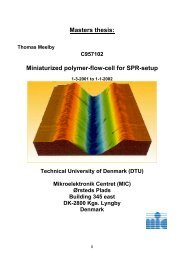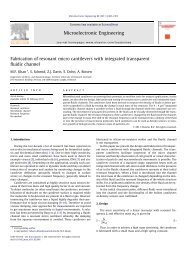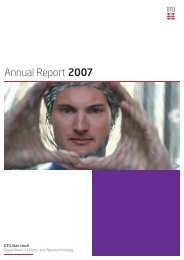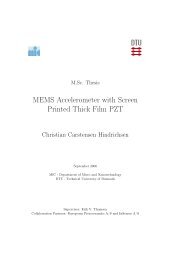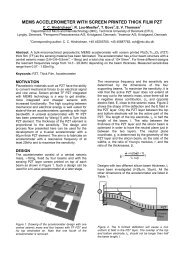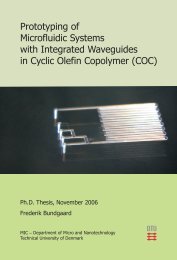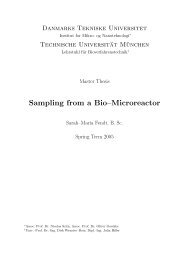Development of a Oxygen Sensor for Marine ... - DTU Nanotech
Development of a Oxygen Sensor for Marine ... - DTU Nanotech
Development of a Oxygen Sensor for Marine ... - DTU Nanotech
Create successful ePaper yourself
Turn your PDF publications into a flip-book with our unique Google optimized e-Paper software.
44 CHAPTER 5. FABRICATION<br />
Thermometer), Ag (Reference Electrode), and Au (Contacts) are deposited.<br />
Why these 3?<br />
As discussed previously Pt and Ag have been used almost exclusively <strong>for</strong><br />
Clark <strong>Sensor</strong>s, and referenced as the best suited metals from a dissolved oxygen<br />
sensor[37].<br />
Where as Au gold provides an excellent surface <strong>for</strong> bonding to wirebond, as<br />
well as being able resist some exposure to saltwater.<br />
Figure 5.7: Illustration <strong>of</strong> the wafer with the three metals added.<br />
Figure 5.8: Alignment marks after the metals are added. From left to right,<br />
ignoring the first one, it is Pt(brown), Ag(light brown), Au(red).<br />
Each metal have double alignment marks, two boxes and a crisscross<br />
pattern. This is mainly to have a little extra safety when<br />
aligning the masks, so that there is always another alignment<br />
mark to check with.<br />
Pt will be put on first <strong>for</strong> two reasons; It is the metal with the smallest<br />
structure, and hence the metal where the lithography step is most sensitive,<br />
and there<strong>for</strong>e where it is most like to go wrong. Also since the Au-Contacts<br />
and the Pt-Thermometer crosses, having the PT buried beneath the Au will<br />
ensure an unbroken line (Especially as the Au, 3000 ˚A, layer is over 10 times<br />
as thick as the Pt, 200 ˚A, layer).<br />
A minor problem however is that a lot <strong>of</strong> metals have poor adhesion to<br />
many <strong>for</strong>ms <strong>of</strong> Silicon (including Silicide), hence a titanium layer is added



